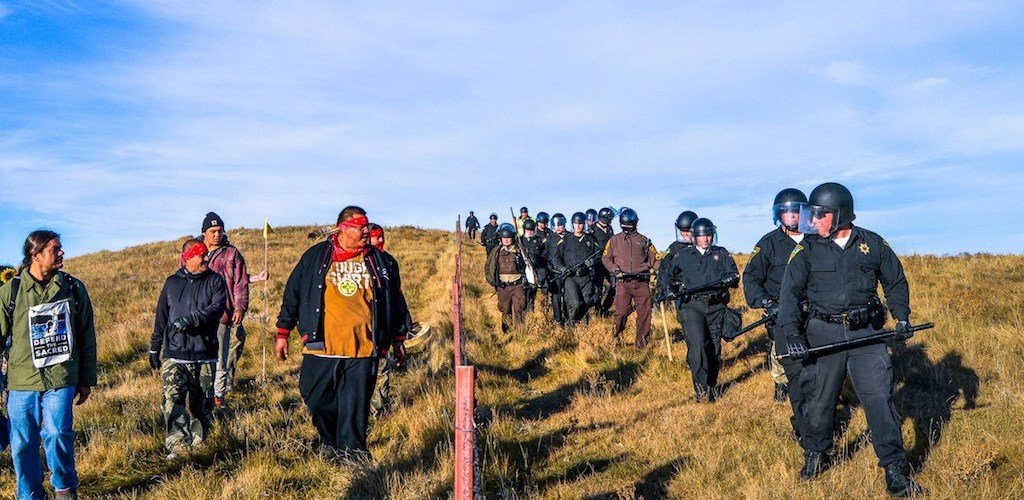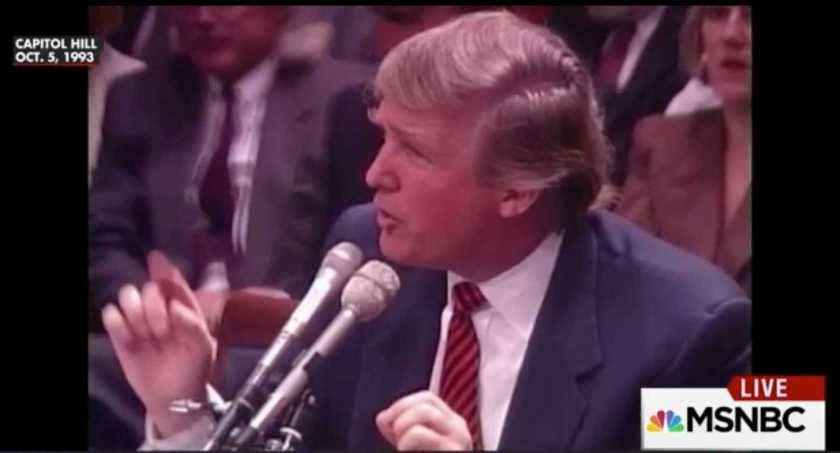TRUMP VS. NATIVE AMERICANS: EXPLORING A VENDETTA
Written and published by Michelle Lietz Ph.D. candidate, Department of English, Theatre, Film & Media, University of Manitoba
Trump’s decision to directly intervene on behalf of oil companies to allow the Dakota Access and Keystone XL pipelines to move ahead with construction showed a blatant disregard for the rights of Indigenous people. It also wasn’t a surprise. In fact, Trump’s long history of hostility towards Native Americans has been well documented since the ‘90s. In 1993, the same year that he lost a bid to run a casino in Palm Springs, California on behalf of the Agua Caliente band of Cahuilla Indians, Trump testified at a congressional subcommittee hearing where he claimed that “the Indians” were in league with the mob, and organized crime was rampant on reservations. He said, “It will be the biggest scandal ever—biggest since Al Capone” and then claimed to have a list of mob-related evidence against Indigenous tribes, which he refused to produce for official evidence, claiming it was all, “common sense.” The entire transcript of Trump’s testimony at this hearing seems to be a kind of prequel to the speeches at his rallies in the 2016 Primaries, full of the repetition of broken clauses, circular logic, and the childish tone accompanying a list of what he considers “unfair.”In the case of this particular congressional hearing, what Trump considered unfair was the money he had to pay in taxes for his casinos. After his many claims of mob activity didn’t seem to be getting him anywhere, Trump brought out the familiar trope of, “The Indians don’t have to pay taxes” and claimed that they were given an unfair advantage in running casinos. He started complaining about all the unfair advantages the Pequot casino was getting while his casinos in Atlantic City had to pay billions of dollars in taxes, and he said, “but my opponent is competing and paying no tax. It is not a fair situation. It is not fair to the States.” It’s telling that Trump chose to speak about these separate casinos as a competition—as a game that he was “unfairly” losing—but even more telling is how he sets up Native Americans as against “the States.” Throughout his testimony, Trump references “the Indians” as if they are just one people; he doesn’t seem to understand that there are over 500 different sovereign nations in the United States. While this would be enough to set off alarm bells for most Natives, as it turns out, there is a great deal more about Native Americans that Trump simply does not understand. Perhaps the most alarming ignorance displayed in this congressional testimony comes when Trump gives his thoughts on the sovereignty of tribal nations in the United States:I listen about sovereign nation, the great sovereign nation, and yet $30 billion to all of the various programs was contributed to the sovereign nation for education, for welfare, for this, for that. I listened as to sovereign nation, and yet the sovereign nation and the people of the sovereign nation have the right to vote in our country. I listen as to sovereign nation, all of the medical, all of the other treaties. I want to know, can Indians sign treaties with foreign nations? Can they go and sign a treaty with Germany? The answer is no. How is it a sovereign nation?It is clear from his own words that not only does Trump not understand tribal sovereignty, he simply does not believe in it. His ignorance is hardly surprising on this front, as most of the general public in the United States has only a fuzzy understanding of tribal sovereignty and Indigenous rights, but to be outright dismissive of treaty rights and Indigenous sovereignty should indeed be alarming.
Trump testifying in 1993: “They don’t look like Indians to me.” (Source: Washington Post)
Finally, towards the end of his testimony, referring again to the Pequot, he says to Congressman George Miller, “If you look at some of the reservations that you’ve approved, I will tell you right now, they don’t look like Indians to me.” Congressman Miller’s prompt response was “thank god that’s not the test of whether or not people have rights in this country, whether or not they pass your look test.” Twenty-three years later, Miller’s response simply sounds foreboding. If Trump does not even believe in Native American people who don’t meet his stereotypical standards, how could be he possibly believe in any rights for Native Americans, especially the much-disputed and never-honored rights to treaty lands? This testimony is only a sampling of the vile rhetoric Trump often uses when discussing Native Americans, especially when he sees Native tribal rights or actions of self-determination (including rights to gaming) as threatening to his empire.In 2000, when the St. Regis Mohawks announced a plan to open a new casino, Trump dished out over $1 million for an ad campaign against the Mohawk tribe. These ads included statements like, “Indians are not required to pay any state or federal taxes and are completely unregulated” while suggesting the tribe had mob ties and “the Mohawk Indians have a long and documented history of criminal activity, including drug dealing, cigarette and alcohol smuggling, illegal immigrant trafficking and violence.” Proofs of these racist ads were published by the Los Angeles Times in June 2016, with various notes of approval accompanying Trump’s signature even though the ads were run through a front group called the New York Institute for Law and Society. In an opinion piece from Indian Country Media Network, journalist Simon Moya-Smith responds to one of these ads by referring to Trump as a “demonizing dick” and claiming of the ad, “The thing should stand as an example of American capitalist propaganda and rhetoric, and abhorrent Trump assholery.”
“The Donald’s” initial approving ads attacking the St. Regis Mohawk Indian tribe (see the L.A. Times for this and other such ads).
While this racialized rhetoric against Native Americans took a backseat to his many other targets in the 2016 Primaries, he has periodically reminded the public of his disrespect for Native Americans through actions such as repeatedly referring to Elizabeth Warren as Pocahontas and deciding to hang a portrait of “Indian-Killer” Andrew Jackson in the oval office.And now, using the same language from his congressional testimony when he talks about the Dakota Access Pipeline and Standing Rock, he claims he wasn’t aware of any objections to the executive order, that everyone understood how unfair it all was for the oil companies. Now, Trump talks about building a wall while Native tribes like the Tohono O’odham proclaim that they would never allow such a thing to cross Native lands. From the very beginning, one of the most important aspects of what has been happening at Standing Rock has been the way events there have exposed the powerful ignorance of, and indifference to the rights of Indigenous people and Indigenous sovereignty. And to be frank, it’s terrifying to think of what could happen with a president who doesn’t believe in Indigenous sovereignty, who doesn’t think Indigenous land claims are fair to businesses, and who can so easily tune out the millions of dissenting voices from around the world. With threats of privatizing Indigenous lands hanging in the air, and the effects of the Termination Era still lingering, it isn’t hard to imagine what Trump might do if he sees any Native Nation standing in the way of his empire. For me, it doesn’t matter how many times Trump says he has respect for “the Indians.” All I hear is him saying, “they don’t look like Indians to me.”
References: Moya-Smith, Simon. “Here’s the Ad Trump Used to Demonize Native Americans.” Indian Country Media Network. July 19, 2016.“Trump at 1993 congressional hearing: ‘They don’t look like Indians to me.’” Los Angeles Times. June 17, 2016.“Trump Personally Approved ads Slamming Indian Tribe: ‘This could be good!’” Los Angeles Times. June 29, 2016.
March 9, 2017




